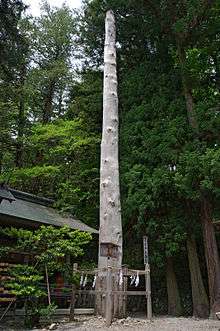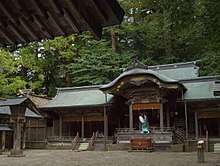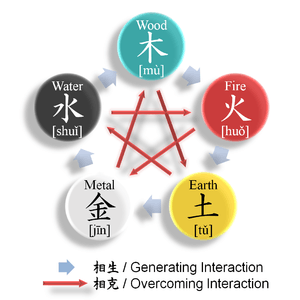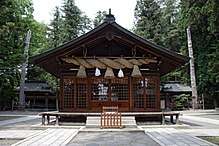Onbashira
The Mihashira or Onbashira (Japanese: 御柱, honorific prefix 御 on-/mi- + 柱 hashira 'pillar') are four wooden posts or pillars that stand on the four corners of local shrines in the Lake Suwa area of Nagano Prefecture (historical Shinano Province), Japan. The largest and most famous set of onbashira are those that stand on the four shrines that make up the Suwa Grand Shrine complex.
| Onbashira Festival Shikinen Zōei Mihashira Taisai (式年造営御柱大祭) | |
|---|---|
 A raised onbashira in the Shimosha Harumiya, one of the four main shrines of the Suwa Grand Shrine complex | |
| Frequency | Every 6 years |
| Location(s) | Lake Suwa area (Hara, Fujimi, Chino, Suwa, Shimosuwa, Okaya), Nagano Prefecture |
| Coordinates | 36°04′31″N 138°05′29″E |
| Country | Japan |
| Years active | circa 1,200 |
| Inaugurated | circa late 8th century? |
| Most recent | 2016 |
| Next event | 2022 |
| Website | www |
By custom, the onbashira are replaced every six (traditionally reckoned as seven) years, in the years of the Monkey and the Tiger in the Chinese zodiac. In Suwa Shrine, this occurs during the Onbashira Festival (御柱祭, Onbashira-sai), which also functions as a symbolic renewal of the shrine's buildings. During the festival, sixteen specially-chosen fir trees are felled and then transported down a mountain, where they are then erected at the four corners of each shrine. Festival participants ride the onbashira as they are slid down the mountain, dragged to the shrine, and raised, and the festival has the reputation of being the most dangerous in Japan due to the number of people regularly injured or killed while riding the logs. This festival, which lasts several months, consists of two main segments, Yamadashi and Satobiki. Yamadashi traditionally takes place in April, and Satobiki takes place in May.[1]
Background
Suwa Shrine
What is known today as 'Suwa (Grand) Shrine' (諏訪大社 Suwa Taisha) was originally two distinct sites made up of four individual shrines: the Honmiya (本宮) and the Maemiya (前宮) comprise the Upper Shrine (上社 Kamisha) located in the modern-day cities of Suwa and Chino on the southeastern side of Lake Suwa, respectively, while the Harumiya (春宮 'spring shrine') and Akimiya (秋宮 'autumn shrine') in the town of Shimosuwa on the opposite (northern) side of the lake make up the Lower Shrine (下社 Shimosha).[2][3][4][5]

The shrine's deity, known either as Suwa Daimyōjin or Takeminakata, was worshipped since antiquity as a god of wind and water,[6] as well as a patron of hunting and warfare.[7] In this latter capacity, he enjoyed a particularly fervent cult from various samurai clans during the Middle Ages.[8] The Upper Shrine is dedicated to Suwa Daimyōjin himself, while his consort, the goddess Yasakatome, is worshipped in the Lower Shrine.
Like others among Japan's oldest shrines, the Kamisha Honmiya and the two shrines of the Shimosha do not have a honden, the building that normally enshrines the shrine deity.[9] Instead, the Upper Shrine's objects of worship were the sacred mountain behind the Honmiya,[10][11] a sacred rock (磐座 iwakura) upon which Suwa Daimyōjin was thought to descend,[12] and the shrine's former high priest or Ōhōri (大祝) who was considered to be the physical incarnation of the god himself.[13] This was later joined by two Buddhist structures (no longer extant since the Meiji period): a stone pagoda in the shrine's inner sanctum known as the Tettō (鉄塔 'iron tower') and a sanctuary to the bodhisattva Samantabhadra (Fugen) - Suwa Daimyōjin being considered to be a manifestation of this bodhisattva - on the sacred mountain.[14] Meanwhile, the Lower Shrine's objects of worship are sacred trees: a sugi tree in the Harumiya, and a yew tree in the Akimiya.[9][15]
.jpg)
Unlike today, there were originally far fewer buildings in the precincts: in the Kamisha Honmiya's case, medieval records for instance indicate that the shrine's most sacred area where a worship hall (haiden) now stands once featured only a torii gate and the god's dwelling place, the iwakura, demarcated by a kind of fence (格子 kakusu).[16][17]
The onbashira
All four shrines of the Suwa Shrine complex are each surrounded on their four corners by large wooden pillars known as the onbashira. These pillars are all currently made out of momi fir tree trunks,[18] though wood from other trees such as larch or Japanese cedar were also used in the past.[19]
The largest of a set of four onbashira, measuring 5 jō and 5 shaku (approx. 16.6 meters) high, is designated as the 'first pillar' or ichi no hashira (一の柱), while the remaining three pillars - the ni no hashira (二の柱 'second pillar'), san no hashira (三の柱 'third pillar'), and yon no hashira (四の柱 'fourth pillar') - are 5 jō (approx. 15 m), 4 jō and 5 shaku (approx. 13.6 m), and 4 jō (approx. 12 m), respectively.[20]
An onbashira's girth is traditionally determined by measuring the uncut tree's circumference at eye level (目通り medōri).[20][21] The actual thickness of the logs used may vary: the largest onbashira in recent history in terms of girth is the Akimiya's ichi no hashira used in the festival of 1950 (Shōwa 25).[21][22]
Aside from the large onbashira at Suwa Shrine, smaller onbashira are also erected in its branch shrines throughout the country. Onbashira are also found in many local shrines in historical Suwa district (see pictures on left).

Origins and symbolism
The onbashira's origins and original purpose are shrouded in mystery. They have been variously interpreted among other things as relics of much larger structures, a kind of barrier or boundary marker (cf. the Korean jangseung), as totem poles,[23] or even as symbolic substitutes for rebuilding the entire shrine complex.[24] Some scholars meanwhile consider the practice of erecting sacred pillars to derive ultimately from prehistoric tree worship, citing the remains of wooden poles or slabs discovered in various Jōmon period sites in apparently ritualistic contexts as potential parallels to the Suwa onbashira.[25][26][27][28][29]
.png)
Onbashira and Chinese philosophy
Possible influences by the Chinese theory of the five elements and the concept of the Earthly Branches in the ceremony of erecting onbashira - at least that of the Upper Shrine - have been observed. For instance, the ritual roughly reflects the elements' cycle of generation (wood begets fire, fire begets earth, earth begets metal), in that the Upper Shrine's onbashira are made out of trees from a mountain to the east (associated with the element of wood) and are brought to the shrine, located south (= fire) of Lake Suwa (= north, water) in order to replace old onbashira (= earth), which are taken down and brought to Hachiryū Shrine in the former village of Chū-kaneko (中金子, 金 = metal), now a part of Suwa City.[30] The custom of hammering ornamental sickles (nagikama) to the trees selected to become onbashira has also been linked to the idea of the element of metal overcoming wood, with the sickle being thought to pacify or 'cut' violent winds, which is associated with the wood element (cf. Suwa Daimyōjin being a wind god).[31]
The generating relationship between wood and fire and their connection with the Suwa deity is also seen in a medieval document known as the Suwa Shichū (陬波私注), which associates Suwa Daimyōjin's birth and later 'disappearance' with the year of the Yang Wood Horse (甲午 kinoe-uma), the Horse being associated with the south, the direction of fire.[32]
The timing of the Onbashira Festival, which falls during the Zodiac years of the Tiger and the Monkey, and the rebuilding of the Upper Shrine's hōden or treasure halls (see below) at noon - the hour of the Horse - are seen as corresponding with the concept of the Three Unities (三合, Chinese: Sānhé, Japanese: Sangō),[33] where four of the five elements are assigned three branch signs each, representing 'birth' (長生), 'peak' (帝旺), and 'burial' (墓).[34][35] The zodiac signs of the Tiger and the Horse are both associated with the 'birth' and 'peak' aspects of fire.[33]
History of the festival
.jpg)
Origins
Suwa Shrine's Onbashira Festival, officially known as the Shikinen Zōei Mihashira Taisai (式年造営御柱大祭, lit. "Great Festival (of the) Periodic Building (of the Shrines and the) Mihashira"),[36] is popularly reckoned to have a 1,200 year history.[37][38][1] The Suwa Daimyōjin Ekotoba (written 1356) claims that the custom of reconstructing (造営 zōei) shrine edifices during the years of the Monkey and the Tiger started during the reign of Emperor Kanmu in the late 8th to early 9th century (early Heian period).[39][27][28]
One legend concerning Suwa Daimyōjin claims that he appeared to the general Sakanoue no Tamuramaro, appointed by Emperor Kanmu to subjugate the indigenous Emishi of northeastern Japan.[7][40][41][42] In thanksgiving for the god's miraculous assistance in Tamuramaro's campaign, the imperial court was said to have decreed the establishment of the various religious ceremonies of Suwa Shrine.[43]
Kamakura, Muromachi, and Sengoku periods
.jpg)
According to the Suwa Daimyōjin Ekotoba, the periodic rebuilding (造営 zōei) of structures (every six years) in the Upper and Lower Shrines such as the 'treasure halls' or hōden (宝殿) where the shrines' mikoshi are kept was decreed to be a 'perpetual duty' (永代の課役 eidai no kayaku) of the whole province of Shinano, with the inhabitants of the various districts of the province responsible for organizing the event.[39][27] Such was indeed the case until the shrines experienced a period of decline during the Sengoku period.[39]
The Ekotoba describes the preparations for the rebuilding thus: at the onset of spring, the governor (kokushi) of Shinano would appoint officials who collected the necessary funds from the populace from checkpoints or toll booths (関 seki) set up in provincial roads in exchange for mifu (御符), official certifications stamped with the sacred seals of the Upper and Lower Shrines.[44][45] The rebuilding of the shrines was undertaken by artisans assembled from all across the province, while thousands of people were assigned the task of erecting the onbashira into place, one or two thousand for each pillar.[46]
Due to the exorbitant amount of money required for the project, locals traditionally avoided or postponed special occasions like marriages, coming-of-age ceremonies, or even funerals during the year.[47][48] In addition, observance of the event in the proper time was considered essential: failure to obey these taboos was thought to incur divine punishment.[49]
The upheavals of the Sengoku period threatened Suwa Shrine and its religious rites. Indeed, the shrine's ceremonies would have been lost to oblivion had not the warlord Takeda Shingen, a staunch devotee of the Suwa deity, took steps to revive their performance.[50] In 1565, after he had fully conquered the whole of Shinano Province, Shingen issued an order for the reinstitution of the religious rites of both the Kamisha and the Shimosha, the zōei being one of them.[51][52]
In 1582 (Tenshō 10), the eldest son of Oda Nobunaga, Nobutada, led an army into Takeda-controlled Shinano and burned the Upper Shrine of Suwa to the ground.[53][54][55] The shrine, which was destroyed in the invasion, was subsequently rebuilt on schedule two years later, in 1584 (Tenshō 12, year of the Yang Wood Monkey).[48]
Edo period onwards
The introduction of the bakuhan system in the Edo period effectively ended the 'perpetual' obligation of periodically rebuilding the shrines and replacing their onbashira being imposed on the whole province of Shinano. Since then, these duties became the sole affair of the villages of Suwa (a.k.a. Takashima) Domain, where the shrines were.[56]
It is from around the Edo and the following Meiji periods[57] that the raising of the onbashira gradually turned into a grand festival, overshadowing the zōei itself. It is thought that some of the current practices associated with the event may have been influenced by the rebuilding ceremony practiced at Ise Shrine.[58] By the later half of the period, viewing galleries were being built for the huge crowds who gathered to witness the festival.[48]
The establishment of State Shinto after the Meiji Restoration in 1868 changed the religious landscape of Suwa. As the union between Shinto and Buddhism that existed then at the shrines—as in most places in Japan—was brought to an end[59] and control over the Upper and Lower Shrines (merged into a single institution in 1871) was turned over from local priestly families to the government, the Onbashira Festival itself underwent massive changes.[48]
Formerly, the task of procuring and raising the onbashira were assigned to different villages every time via mutual agreement. In 1890, it was decided that lottery will be used henceforth to determine which villages will be assigned which onbashira during a given festival.[48][60] While the villages under the Upper Shrine's jurisdiction (currently districts in the modern-day cities of Chino and Suwa, the town of Fujimi, and the village of Hara) are still allotted their respective onbashira via lottery to this very day, the responsible villages for the Lower Shrine's onbashira soon decided to do away with the lottery for the 1902 festival and instead permanently assigned particular villages to a particular onbashira, an arrangement that continues to this day.[61][62]

The Lower Shrine's iconic Kiotoshi, wherein the onbashira are slid down a steep hill (the Kiotoshi-zaka) as men attempt to ride it, originated from the Meiji period onwards. Unlike the Upper Shrine, which had a specially-designated area from which to obtain the wooden logs, the Lower Shrine originally used tree trunks obtained from different nearby mountains; it was not until 1895 that the forest of Higashimata (東俣) in Shimosuwa was established as the sole source for the Lower Shrine's onbashira and the current route which passes through the hill was adopted.[63]
In 1914 (Taishō 3), 21-year-old Tomoya Nakamura (中村知也) became the first known person to ride an onbashira as it was being slid down the Kiotoshi-zaka. He is said to have repeated the same feat during the subsequent five festivals, making him a local legend.[64] It apparently took some time for others to imitate Nakamura: a photograph attached to a newspaper article about the festival in 1920 distinctly shows no one on the onbashira depicted.[65] It was only from the festivals of 1926 and 1932 that reports of log-riding began to appear.[66]
During the final years of World War II, as Japan's military situation became more desperate, the government began altering its original conscription laws, so that in 1943, all male students over the age of 20 became subject to the draft, whereas they had formerly been exempted. By 1944, men under 20—some as young as 15—were being pressured to serve in the military.[67][68] Due to the lack of able-bodied adult men, the Onbashira Festival of 1944 (Shōwa 19) was performed mainly by women (who formerly did not take part in the proceedings) and by older men who were not pressed into military service.[69] During the festival, then mayor of Shimosuwa, Tokichi Takagi (高木十吉), died from an accident during the Yamadashi. It has since become customary to pray for safety during the proceedings before a monument dedicated to his memory.[70][71]
The festival of 1950 (Shōwa 25), the first to be held after the war, marked the first time women were officially allowed to participate in the event.[48]
Description of the festival
Selecting the trees
Preparations for the festival commences with the process of selecting the trees that will be turned into onbashira, the Mitate (見立て). In the Upper Shrine's case, a preliminary inspection (仮見立 Kari-mitate) is performed two years before a given festival, with the formal selection process (本見立 Hon-mitate) being held a year after this.[72]
The Upper Shrine's onbashira are made from momi fir trees procured from Mount Okoya (御小屋山 Okoya-san) - part of the Southern Yatsugatake Mountains - in the village of Hara,[73] while those of the Lower Shrine are taken from the forest of Higashimata (東俣) in the town of Shimosuwa.[73]
_Nagano%2CJAPAN.jpg)
Yamadashi
Yamadashi literally means "coming out of the mountains". Sixteen fir trees, usually about 17 to 19 metres (56 to 62 ft) tall, are selected and cut down in a Shinto ceremony using specially-made axes and adzes.[38][1] The logs are decorated in red and white regalia, the traditional colors of Shinto ceremonies, and ropes are attached. During Yamadashi, teams of people drag the logs down the mountain towards the shrine. The course of the logs goes over rough terrain, and at certain points the logs must be skidded or dropped down steep slopes. Young men prove their bravery by riding the logs, which can weigh as much as 12 tons,[74] down the hill in a ceremony known as Kiotoshi ("tree falling").
Satobiki
During Satobiki, held about a month later, the logs are paraded to the four shrine buildings where they will be erected: Honmiya, Maemiya, Harumiya, and Akimiya.[75] Four onbashira are erected at each building, one at each corner. The logs are raised with ropes by hand, and while they are being raised, a ceremonial group of log bearers ride the logs and sing and perform other feats.[38][1] This ceremony was performed as part of the opening ceremonies of the 1998 Winter Olympics in Nagano.[38][75]
After the two festivals, there is an important event "Building of Hoden". This event, which marks the end of Onbashira, is not as famous as Yamadashi and Satobiki.
Incidents
Onbashira has a reputation for being the most dangerous festival in Japan, and it has led to the injury and death of participants. There were fatal incidents in 1980, 1986, 1992,[76] 2010,[76][77] and 2016.[76] In 1992, two men drowned while a log was being pulled across a river.[76] In 2010, two men, Noritoshi Masuzawa, 45, and Kazuya Hirata, 33, died after falling from a height of 10 metres (33 ft) as a tree trunk was being raised on the grounds of the Suwa Grand Shrine. Two other men were injured in the same accident, which organizers say occurred when a guide-wire supporting the 17-metre (56 ft) tree gave way.[77] In 2016, one man died falling from a tree as it was being raised at the shrine.[76]
See also
- Suwa taisha
- Takeminakata
- Mishaguji
- Totem pole
References
- Anthony Blair Guardia (4 December 2015). "The Onbashira Festival 2016". Go! Nagano. Nagano Tourism Board. Retrieved 4 August 2016.
- "Suwa-taisha (諏訪大社)". 長野県下諏訪町の観光情報.
- "Suwa Grand Shrine (Suwa Taisha)". Go! Nagano (Nagano Prefecture Official Tourism Guide). Archived from the original on 2019-04-04. Retrieved 2017-12-11.
- Tanigawa, ed. (1987). p. 129.
- "Shrines and Temples". Suwa-taisha shrine. Japan National Tourist Association. Retrieved 21 September 2010.
- Yazaki (1986). p. 22.
- Yazaki (1986). p. 24.
- Yazaki (1986). p. 25.
- "Suwa Shinkō". Encyclopedia of Shinto. Retrieved 21 September 2010.
- "守屋山と神体山". 諏訪大社と諏訪神社. 八ヶ岳原人.
- "Suwa Taisha Shrine". JapanVisitor Japan Travel Guide.
- Tanigawa, ed. (1987). p. 132-135.
- Tanigawa, ed. (1987). p. 135-136.
- Inoue (2003). pp. 349-350.
- Tanigawa, ed. (1987). p. 142.
- Miyasaka (1992). p. 159.
- Yazaki (1986). p. 96.
- "Suwa Grand Shrine (Suwa Taisha)". Go! Nagano (Nagano Prefecture Official Tourism Guide). Archived from the original on 2019-04-04. Retrieved 2017-12-11.
- "教えて!御柱祭(2)[Q]御柱は何本でどんな木?". 御柱祭 信州特殊サイト. The Shinano Mainichi Shimbun.
- "御柱のサイズ比較!太い順に全部並べてみた". ヨーイサヤレヨーイサ(β).
- Miyasaka (1992). p. 180.
- "現存する最大の御柱". 諏訪大社と諏訪神社(附・神社参拝記). 八ヶ岳原人.
- "御柱祭のルーツ". 信州遠山郷 秘境の旅. Toyamago Sight Seeing Information Center (遠山郷観光協会).
- Muraoka (1969). pp. 87-89.
- NHK (26 June 2016). 「御柱」~最後の“縄文王国”の謎~ (Onbashira: Saigo no Jōmon ōkoku no nazo) (Documentary). Japan: NHK.
- Matsui, Keisuke (2013). Geography of Religion in Japan: Religious Space, Landscape, and Behavior. Springer Science & Business Media. p. 26. ISBN 978-4431545507.
- Miyasaka, Mitsuaki (1992). 諏訪大社の御柱と年中行事 (Suwa Taisha no Onbashira to Nenchū-gyōji). Nagano: Kyodo Shuppansha. pp. 155–156. ISBN 978-4876631780.
- "御柱祭とは". 信州諏訪 御柱祭. Suwa Tourism Association.
- "御柱祭のルーツ". 信州遠山郷. 遠山郷観光協会.
- Hara, Naomasa (2012). 龍蛇神: 諏訪大明神の中世的展開 (Ryūjajin: Suwa Daimyōjin no Chūseiteki Tenkai). Ningensha. pp. 224–226. ISBN 978-4931388710.
- Ōwa, Iwao (1987). 諏訪の神と古代ヤマト王権 (Suwa no Kami to Kodai Yamato Ōken). In Tanigawa, ed. pp. 178-180.
- Hara (2012). pp. 219.
- Hara (2012). pp. 221-222.
- Cook, Constance (2006). Death in Ancient China: The Tale of One Man's Journey. Brill. pp. 86–87. ISBN 978-9047410638.
- Beijing Foreign Language Press (2012). Chinese Auspicious Culture. Translated by Shirley Tan. Asiapac Books Pte Ltd. p. 9. ISBN 978-9812296429.
- "御柱祭(式年造営御柱大祭)". 信州諏訪観光ナビ. Suwa Local Tourism Association (諏訪地方観光連盟).
- Wataru Miura (2 April 2016). "Risking life and limb in a festival held only once every six years". The Asahi Shimbun. Retrieved 4 August 2016.
- "Onbashira Festival". Japan Atlas. Ministry of Foreign Affairs of Japan. Retrieved 4 August 2016.
- Tanigawa, ed. (1987). p. 152.
- Konishi (2014). p. 526.
- Yamashita (2006). pp. 13-14.
- Wakita (2007). p. 92.
- Muraoka (1969). p. 87.
- Miyasaka (1992). pp. 156-157, 163-164.
- "諏訪大社本宮の「宝殿と遷座」". 諏訪大社と諏訪神社(附・神社参拝記). 八ヶ岳原人.
- Miyasaka (1992). pp. 156-157.
- Miyasaka (1992). p. 154.
- "御柱の歴史~諏訪市博物館「御柱とともに」より~". 御柱祭いくぞやい. Suwa City.
- Miyasaka (1992). pp. 157-159.
- Matsui (2013). p. 24.
- Tanigawa, ed. (1987). pp. 137, 152-153.
- Yazaki (1986). p. 26.
- Turnbull (2012). p. 156.
- Furukawa (1988). p. 148.
- "法華寺(ほっけじ)". homtaすわ.
- Tanigawa, ed. (1987). p. 153.
- Ishikawa (2008). p. 112.
- Yazaki (1986). p. 45.
- Inoue (2003). pp. 362-371.
- "【御柱抽籤式】たかがくじ引き、されどくじ引き。責任重大の抽籤に各地区総代が出陣!!". ヘソで茶をわかす.
- "御抽選". 上社御柱情報サイト Kamisya ONBASHIRA. Archived from the original on 2016-05-11. Retrieved 2017-12-12.
- Ishikawa (2008). p. 117.
- Ishikawa (2008). p. 113.
- Ishikawa (2008). pp. 113-114.
- Ishikawa (2008). p. 120.
- Ishikawa (2008). pp. 118-120.
- "How Did the Japanese Draft Citizens in World War II?". HistoryNet.com. World History Group.
- "Conscription". The Pacific War Online Encyclopedia.
- 林 郁. "諏訪大社の歴史と御柱の大事な意味". メールマガジン「オルタ」.
- "下社山出し~棚木場→萩倉の大曲前". 御柱祭いくぞやい. Suwa City.
- "諏訪大社御柱祭 平成16年 下社山出し編 その 1". 厭離穢土欣求浄土.
- Miyasaka (1992). p. 164.
- "上社の御柱山「御小屋山」". 御柱祭いくぞやい. Suwa City.
- "Log-riding festival is as odd as it gets". Taipei Times. 11 April 2004.
- Hiroko Yoda (5 May 2010). "Onbashira-sai festival: The log surfers of Lake Suwa". CNN Travel. Retrieved 4 August 2016.
- Julian Ryall (9 May 2016). "Man dies in Japan's most dangerous festival". The Telegraph. Retrieved 4 August 2016.
- Julian Ryall (10 May 2010). "Two die in Japan's notorious tree-sliding religious festival". The Telegraph. Archived from the original on 2016-08-10. Retrieved 21 May 2016.
Works cited
- Furukawa, Sadao (1988). 図説長野県の歴史 (Zusetsu Nagano-ken no Rekishi). Kawade Shobō Shinsha. ISBN 978-4309611204.
- Inoue, Takami (2003). "The Interaction between Buddhist and Shinto Traditions at Suwa Shrine." In Rambellli, Fabio; Teuuwen, Mark (ed.). Buddhas and Kami in Japan: Honji Suijaku as a Combinatory Paradigm. Routledge. ISBN 978-1134431236.CS1 maint: extra text: authors list (link)
- Ishikawa, Shunsuke (2008). "祭りにおける「イベント」の形成に関する基礎研究: 諏訪大社下社御柱祭「木落し」の事例から (The Basic Study for "Event" In Traditional Festival: A Case Study: "Kiotoshi" of Onbashira-matsuri Festival)" (PDF). Journal of the Nagoya University Graduate School of Humanities (in Japanese): 112. ISSN 0910-9803. Archived from the original (PDF) on 2017-12-13. Retrieved 2017-12-12.
- Konishi, Jin'ichi (2014). A History of Japanese Literature, Volume 3: The High Middle Ages. Princeton University Press. ISBN 978-1400861828.
- Matsui, Keisuke (2013). Geography of Religion in Japan: Religious Space, Landscape, and Behavior. Springer Science & Business Media. ISBN 978-4431545507.
- Miyasaka, Mitsuaki (1992). 諏訪大社の御柱と年中行事 (Suwa Taisha no Onbashira to Nenchū-gyōji). Nagano: Kyōdo Shuppansha. ISBN 978-4876631780.
- Muraoka, Geppo (1969). 諏訪の祭神 (Suwa no Saijin). Tokyo: Yuzankaku Shuppan.
- Tanigawa, Ken'ichi, ed. (1987). 日本の神々―神社と聖地〈9〉美濃・飛騨・信濃 (Nihon no kamigami: Jinja to seichi, vol. 9: Mino, Hida, Shinano). Hakusuisha. ISBN 978-4-560-02509-3.
- Turnbull, Stephen (2012). Nagashino 1575: Slaughter at the Barricades. Bloomsbury Publishing. ISBN 978-1782002291.
- Wakita, Haruko (2007). "The Creation of Fabricated Myths in the Medieval Age: An Examination of Shintoshu, Histories (Engi), Noh Plays, and Other Sources" (PDF). In Baxter, James C.; Fogel, Joshua A. (eds.). Writing Histories in Japan. Texts and Their Transformations from Ancient Times through the Meiji Era. International Research Center for Japanese Studies. p. 92.
- Yamashita, Masaharu (2006). "訓読・諏訪大明神絵詞 (一) (Kundoku: Suwa Daimyōjjn Ekotoba 01)" (PDF). Annual report of the Institute of Cultural Sciences, Risshō University (16): 13–14. Archived from the original (PDF) on 2019-01-07. Retrieved 2017-12-07.
- Yazaki, Takenori, ed. (1986). 諏訪大社 (Suwa Taisha). 銀河グラフィック選書 (Ginga gurafikku sensho). 3. Ginga Shobō.
External links
| Wikimedia Commons has media related to Onbashira Festival. |
- YouTube video of Onbashira
- Onbashira Web (in Japanese)